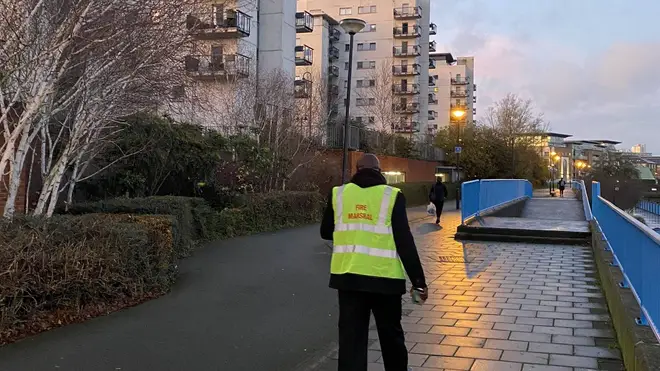
Tom Swarbrick 4pm - 6pm
16 December 2020, 08:51 | Updated: 16 December 2020, 09:56

LBC's Rachael Venables reveals shocking costs of 'Waking Watches' in London
£12 million is being spent every month in London on fire wardens patrolling buildings with fire safety issues like dangerous cladding, LBC can reveal.
Right now, 590 buildings are so unsafe with cladding they need to be patrolled 24/7 by "waking watches".
This is a system which sees staff continually patrolling all floors of a building and the outside to respond immediately to a fire and assist in evacuating residents.
But this resource intensive solution, which has been warned should only be used as an interim measure and not as a substitute for removing unsafe materials from a building, could end up costing flat owners thousands.
I’ve spoken to Lee Malcolmson from Deptford whose building needed a waking watch for three months earlier in the year, costing a total of £210,000.

The cost of a waking watch in Mr Malcomson's building cost £70,000 per month, far above the London average of £20,443.
Mr Malcomson said he and the other 57 flats in his building are now waiting to hear if the cost will be passed on to them.
But with the fees potentially costing over £3,600 per flat, he fears being pushed into bankruptcy.
"We are people who cannot afford to buy on the open market", he said.
"The costs of that alone would be absolutely crippling for some people.
"If it was spread over time I could possibly afford it, but then there are the other costs to account for; the £111,000 alarm that they installed, then the over £3 million for the the cladding."
The worst case scenario, Mr Malcomson said, is being made bankrupt as he can't borrow any more money.
Speaking with LBC's Nick Ferrari on Wednesday, Housing Secretary Robert Jenrick said help "could be on the way" for properties over the dangerous cladding, and admitted leaseholders were "completely blameless" for the issues caused by cladding.

"Waking watch is a necessity to keep people safe, however the evidence that we've seen in recent weeks is that this is a rip-off, people are being charged excessive amounts of money, some of the companies doing these services are not providing a good service to the public and there are better ways that people can be protected.
"The most obvious way to do that is to install sophisticated modern fire alarms which can in many cases replace waking watch and fire wardens altogether."
But when pressed by Nick on who would be responsible for paying for this, Mr Jenrick said it would be either the responsibility for the building owner or the leaseholder - potentially meaning innocent flat owners could be yet again forced to stump up money.
However, some help may be on the way for leaseholders, with Mr Jenrick adding: "We will be saying more on this in the next few days on the topic of waking watch."

Jenrick: Help could be on the way for properties over cladding
A Ministry of Housing, Communities and Local Government spokesperson said: “Waking watches should only be used as an interim measure - they are not a substitute for the swift removal of unsafe cladding.
“Where leaseholders have concerns about waking watch costs they should speak to their building owner, who is responsible for putting safety measures in place.
“Leaseholders can also challenge excessive costs at the First Tier Tribunal and the government is considering how we can further support leaseholders in this situation.”
A London Fire Brigade spokesperson said: “The number of buildings in London with waking watches in place has risen due to the amount of work going on in the built environment where those responsible for fire safety in their buildings are working to identify potential risks, check the compliance of their buildings, carry out surveys and update risk assessments.
“As part of this work, they are informing our inspectors so the Brigade can put plans in place to react to these buildings which are potentially higher risk.
“We should all feel safe in our homes and those responsible for residential buildings have a legal obligation to meet their responsibilities and address all fire safety risks identified.”